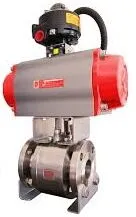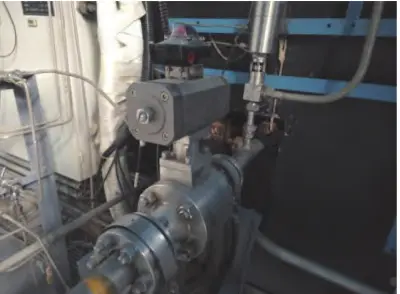Hydrogen Corrosion in High-Pressure Hydrogenation Gate Valves
Jan 02, 2025
In the hydrocracking and hydrorefining processes of the oil refining industry, the high-pressure hydrogenation gate valve plays a critical role in regulating the flow of hydrogen. Its service life and operational stability are essential. Under extreme conditions of high temperature, high pressure, and hydrogen-rich environments, the high-pressure hydrogenation gate valve faces significant challenges, including hydrogen corrosion, erosion from the hydrogen medium, and mechanical wear. These factors can severely affect the valve’s performance and service life. This paper examines the failure modes of the high-pressure hydrogenation gate valve, focusing on hydrogen corrosion and erosion wear, and recommends improvements related to material properties, hydrogen embrittlement, and structural design to enhance the valve’s service life and ensure the safe and stable operation of the entire system.
The high-pressure hydrogenation gate valve regulates the flow and pressure of hydrogen in the hydrocracking and hydrorefining processes. During production, high-pressure hydrogen chemically interacts with raw oil to improve the quality and yield of refined products. The stability of the high-pressure hydrogenation gate valve’s performance is crucial for maintaining the stability of high-pressure hydrogen transport, thereby ensuring the consistent output of the entire refining system. This, in turn, plays a key role in ensuring the safety and efficiency of the refining process. The operating conditions of the high-pressure hydrogenation gate valve include high temperatures (280–450°C) and high pressures (16–27 MPa). The harsh hydrogen-rich environment imposes stringent performance requirements on the valve. To ensure its reliability and durability under these severe conditions, the design and manufacturing of high-pressure hydrogenation gate valves must comply with or exceed relevant standards.
During operation, the high-pressure hydrogenation gate valve is exposed to extreme temperatures and pressures, leading to significant hydrogen corrosion. The valve is vulnerable to failures such as hydrogen embrittlement, stress corrosion cracking, and fatigue, which can result in leakage, system failures, and other critical malfunctions, endangering personnel safety and equipment integrity. Additionally, the high flow rate of hydrogen and mechanical wear during the valve's opening and closing cycles can damage the sealing surfaces, causing internal or external leakage. This undermines the valve’s reliability and shortens its service life. Frequent repairs necessitate production shutdowns, increasing maintenance costs and disrupting normal operations, which can result in substantial financial losses. Since its deployment in the oil refining industry, the valve's service life has been significantly impacted by erosion wear and hydrogen corrosion. This paper provides a comprehensive analysis of the erosion wear mechanisms affecting the high-pressure hydrogenation gate valve and investigates the influence of hydrogen corrosion on valve materials, offering valuable insights for improving the valve’s service life and enhancing its safety performance.
Hydrogen corrosion poses a significant challenge for valves operating in hydrogen or hydrogen-containing environments, with serious implications for their performance. As the oil refining industry advances, hydrogen corrosion in high-temperature and high-pressure conditions has become an increasingly critical concern.
Significant research has been carried out on hydrogen corrosion within the industry, focusing on several primary mechanisms, including:
- Hydrogen Embrittlement: Under high pressure, hydrogen atoms diffuse into the metal lattice, reducing the material's plasticity and toughness, which accelerates material degradation.
- Electrochemical Corrosion: Hydrogen forms an electrochemical corrosion cell with the metal surface, triggering corrosion reactions at the metal interface.
- Chemical Corrosion: Hydrogen reacts chemically with the metal surface, forming hydrides that further degrade the material.
- Stress Corrosion: Hydrogen-induced stress under high pressure accelerates corrosion, increasing the likelihood of material failure.
- Environmental Factors: Environmental factors such as temperature, humidity, and medium composition influence the severity of hydrogen corrosion in high-pressure hydrogenation gate valves.
In a hydrogen-rich environment, hydrogen atoms penetrate the metal lattice, disrupting atomic bonds and resulting in reduced plasticity and toughness, ultimately causing brittle fracture. Hydrogen-induced stress corrosion promotes the formation of stress corrosion cracks as hydrogen atoms interact with stress fields at metal grain boundaries and defects. This accelerates crack propagation, greatly shortening the material's fatigue life. Hydrogen also accelerates the propagation of fatigue cracks, further reducing the material's overall fatigue life. Additionally, hydrogen alters the tribological properties of the material, damaging the oxide film and affecting its lubrication characteristics. This leads to increased friction between components, exacerbating surface wear. When hydrogen corrosion affects the sealing surface, it compromises the integrity of the valve's sealing surface, potentially causing leakage. Severe corrosion can result in operational failure, safety risks, and even catastrophic system failures. Therefore, hydrogen corrosion must be a critical consideration in the design, operation, and maintenance of high-pressure hydrogenation gate valves.
Once hydrogen corrosion initiates in the metal components of the high-pressure hydrogenation gate valve, the following issues typically arise:
- Reduced Mechanical Properties: The yield strength and tensile strength of the material significantly decrease, resulting in a considerable reduction in the material's overall mechanical performance.
- Decreased Ductility: There is a marked reduction in elongation and cross-sectional area, severely impairing the material's plasticity and toughness.
- Fracture Mode Transition: The fracture mode shifts from ductile to brittle, making the material more brittle and harder. Fractures often show intergranular or intragranular patterns.
- Reduced Fatigue Life: Hydrogen atoms accelerate the propagation of fatigue cracks, greatly reducing the material's fatigue life.
In conclusion, hydrogen corrosion is a leading cause of failure in high-pressure hydrogenation gate valves during operation. Several key factors that affect the severity of hydrogen corrosion include:
- Operating Pressure: In high-pressure environments, the interaction between hydrogen and metal materials is intensified, accelerating hydrogen embrittlement.
- Temperature: Elevated temperatures increase the activity of hydrogen molecules, thereby promoting electrochemical corrosion.
- Humidity: Humid environments exacerbate hydrogen corrosion.
- Additional Factors: The purity of the hydrogen medium, selection of valve materials, structural design, and manufacturing processes all play a critical role in the extent of hydrogen corrosion.
Previous: Improvement in High-Pressure Slab Gate Valve Performance
Next: Mitigating Hydrogen Corrosion in High-Pressure Hydrogenation Gate Valves


